Disclosure: Please note that some of the links below area affiliate links and at no additional cost to you I will earn a commission. Know that i only recommend products services and brands i have personally used and stand behind. When you use one of my affiliate links, the company compensates me, which helps me run this blog and keep my in -depth content free of change for readers (like you). Read our disclosure for more info.
A tactic known as “play between the lines” has assisted teams in becoming more offensive and successful in breaking lines through the defending team more frequently. To score goals and keep control of the game, this style of play entails taking advantage of the gaps between the opposition’s lines.
Coaches like Pepe Guardiola, Roberto De Zerbi, Thomas Tuchel, and Angel Postecoglou are bright examples of how playing between the lines can affect a team’s attacking behavior.
We will go over the specifics and importance of playing football between the lines in this article.
Understanding the Lines in Football
Before we explore the dynamics of playing between the lines, it’s essential to understand what these lines represent. The opponent’s formation is divided usually into 3 – 4 lines, including the defensive, midfield, and offensive line with some variations. These lines dictate the positioning and movement of players on the field.
- Disrupting Defensive Organization
A player pushes defenders and especially the centre backs, to make decisions when he occupies a position between the midfield and defensive line. Do they move aside to leave space behind them when they mark the player? Do they stay where they are and take the chance that the player will receive the ball in a hazardous place, giving them enough time to turn and face their goal?
The opponent’s defensive organization is disrupted by this continuous decision-making process. Defenders are forced to read the game continually, which can cause them to become confused, and hesitant, and ultimately make mistakes.
- Creating Passing Lanes and Channels
Playing between the lines opens up passing lanes and channels that are not readily visible from first view. These passing lanes are like Christmas gifts that skilled players can exploit to advance the ball and orchestrate attacks.
For instance, an attacking midfielder who positions themselves between the defensive and midfield lines provides an option for a pass from the backline. This pass effectively bypasses the first line of the opponent’s defense and allows the team to progress up the field more quickly. The player in this position can then distribute the ball to forwards or wingers, facilitating fluid, dynamic attacking movements.
- Quick Transitions and Unexpected Attacks
One of the key advantages of playing between the lines is the ability to transition from defense to attack fast. When a player receives the ball in these spaces, they often have their back to the opponent’s goal. This is where skill and creativity come into play. The player must execute a quick turn to change the direction of the attack or to use the Third Man concept and find a teammate who faces the goal.
These quick transitions catch the opposition off guard. The defenders, having been in a more structured defensive shape, now face a player who can instantly change the game’s rhythm and create goal-scoring opportunities. It’s like a musical interlude in the midst of a symphony, adding an element of surprise to the game.
- Breaking the Opponent’s Lines
Playing between the lines essentially breaks the opponent’s lines of defense. Players who excel in this type of game can open the opposition’s defense, creating gaps and vulnerabilities.
This not only leads to direct goal-scoring opportunities but also draws defenders out of their positions. When a defender commits to closing down a player between the lines, they leave a gap behind them. This gap can then be exploited by a well-timed run from a teammate, leading to a prime scoring chance.
Offensive Players occupying spaces between the lines
Attacking midfielders and forwards necessitate particular attributes that facilitate their excellence in maneuvering between the lines. Their discernment, inventive prowess, and technical acumen distinguish them, positioning these players as the catalysts in orchestrating goal-scoring opportunities. Let us delve into the pivotal role they undertake with greater intricacy.
- Vision and Creativity: One of the defining characteristics of these players is their exceptional vision and creativity. They see opportunities that others may miss and have the ability to read the game several moves ahead. This foresight allows them to exploit the smallest pockets of space between the lines, making them a constant menace to the opposition.
- Technical Proficiency: Technical competence is a quality that attacking players cannot compromise. Their ball control, dribbling, and first-touch abilities are frequently unmatched. Because of this, they can receive the ball in even the clogged areas and hold onto possession even when defenders are under heavy pressure.
- Passing Precision: One of the primary skills in the arsenal of these players is their ability to deliver accurate passes. Meaning that they can pass the ball to their teammate’s correct foot or space with the proper speed and at the appropriate time. They can split defenses with perfectly timed through-balls, chipped passes, or delicate lobs that unlock the opponent’s defense. These passes not only find their intended targets but also create goal-scoring opportunities for their teammates.
- Positioning and Movement: Offensive players need to have extraordinary positional awareness in order to play well between the lines. They know instinctively where to put themselves to receive the ball and take advantage of holes in the other team’s defense. They move with deliberate intent, making planned runs to open up space and move opponents out of position.
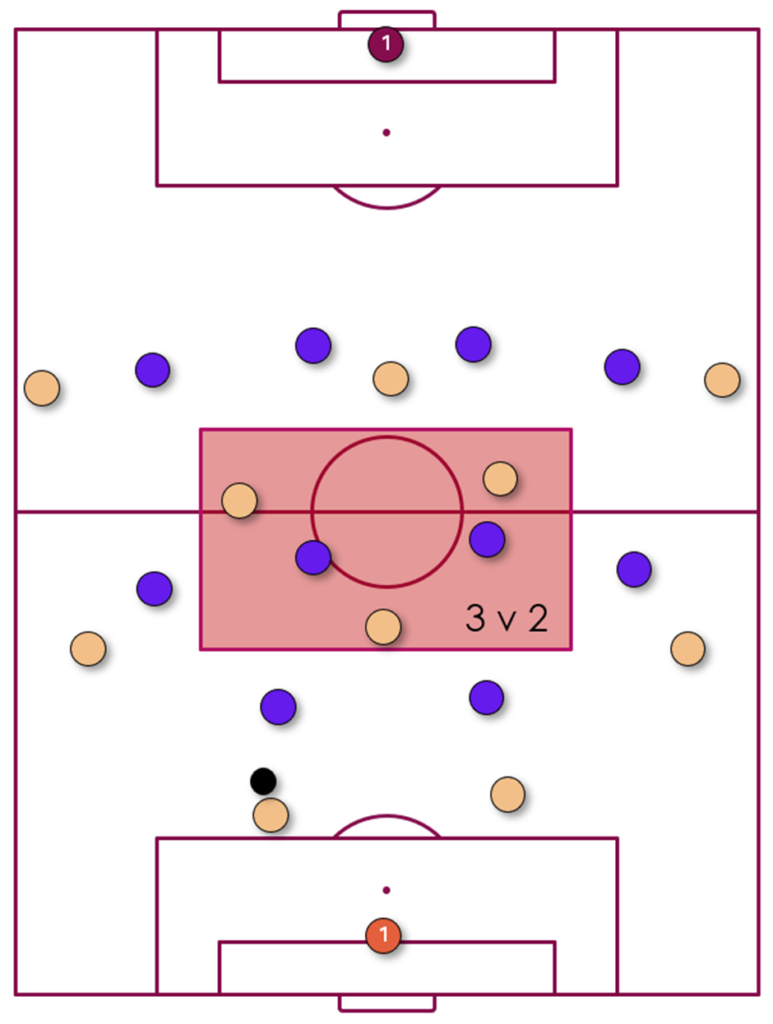
Midfield Dominance
The midfield is frequently denoted as the engine of a soccer team. Positioned in the core of the football field, midfielders assume the role of conductors, controlling the tempo of the match. Occupying the intermediary spaces in midfield is not merely pivotal; it constitutes a transformative factor in the game.
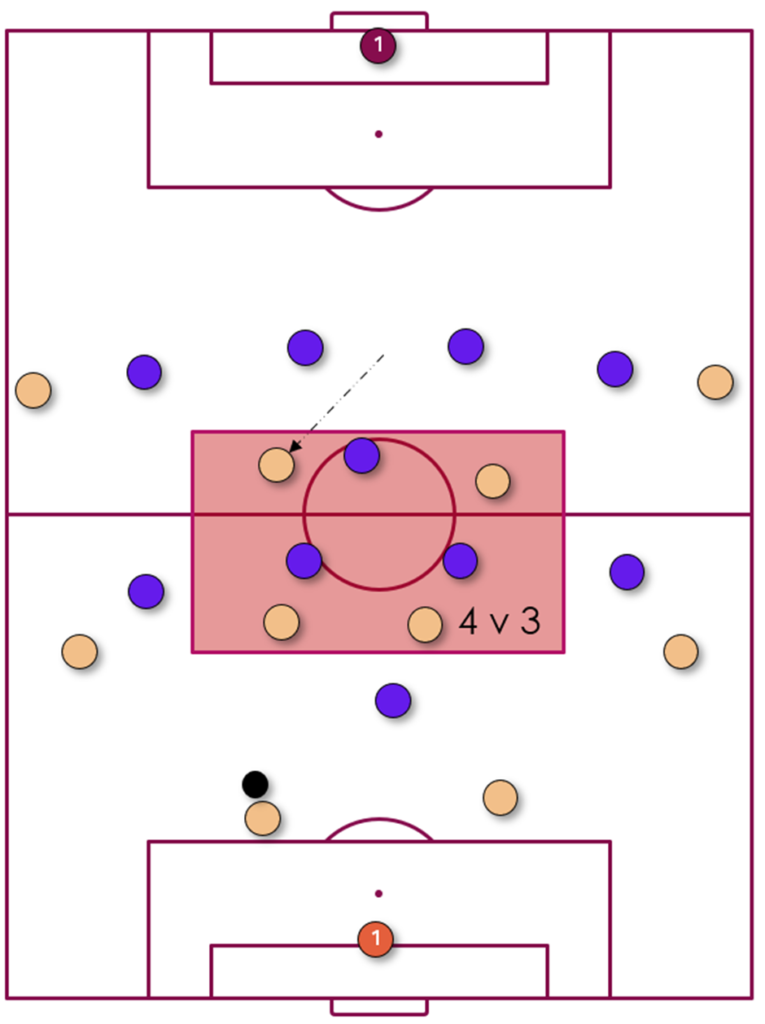
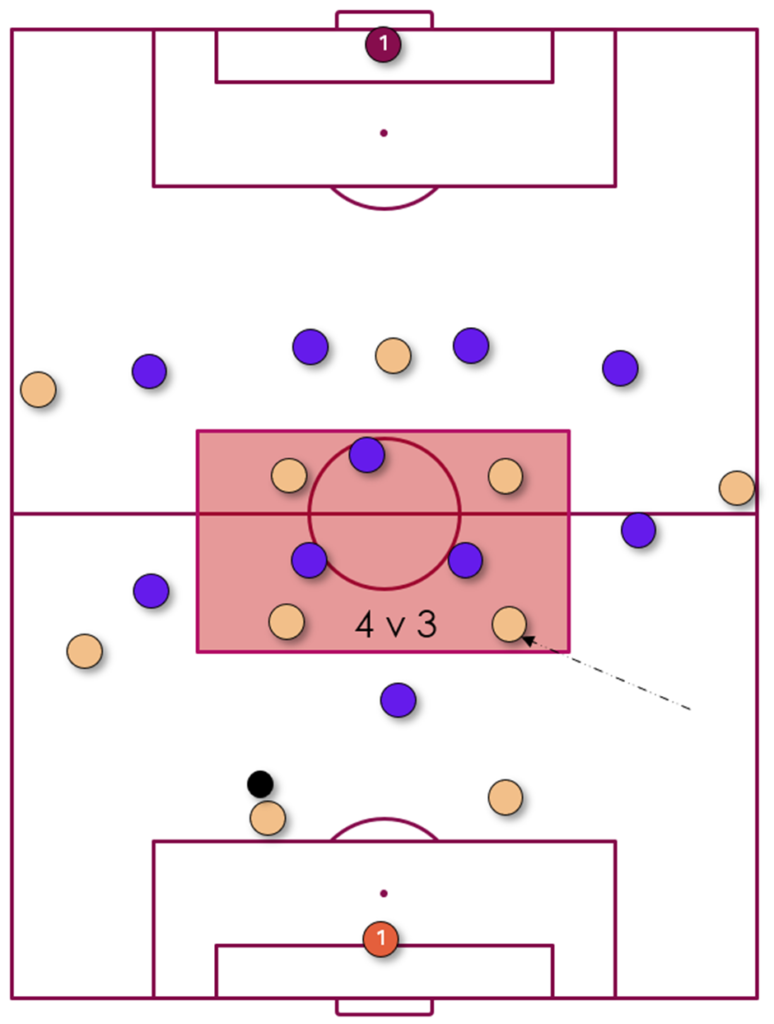
Creative Playmaking
One of the principal duties assigned to midfield maestros is the orchestration of scoring opportunities for their team. Navigating the field between the lines gives them the opportunity to exploit the spaces residing behind the opponent’s lines.
Midfield maestros are distinguished by their extraordinary vision and precision in passing. They possess the skill to identify openings, deliver through balls of impeccable accuracy, and dissect the defense with precision. These “amazing” midfield architects frequently assume the role of catalysts, initiating their team’s offensive movements and combinations.
Players positioned behind the 1st line of pressure should strategically adopt a diagonal position ball carrier. This approach aids in maintaining an optimal body orientation for receiving the ball and promptly shifting focus toward the forward perspective.
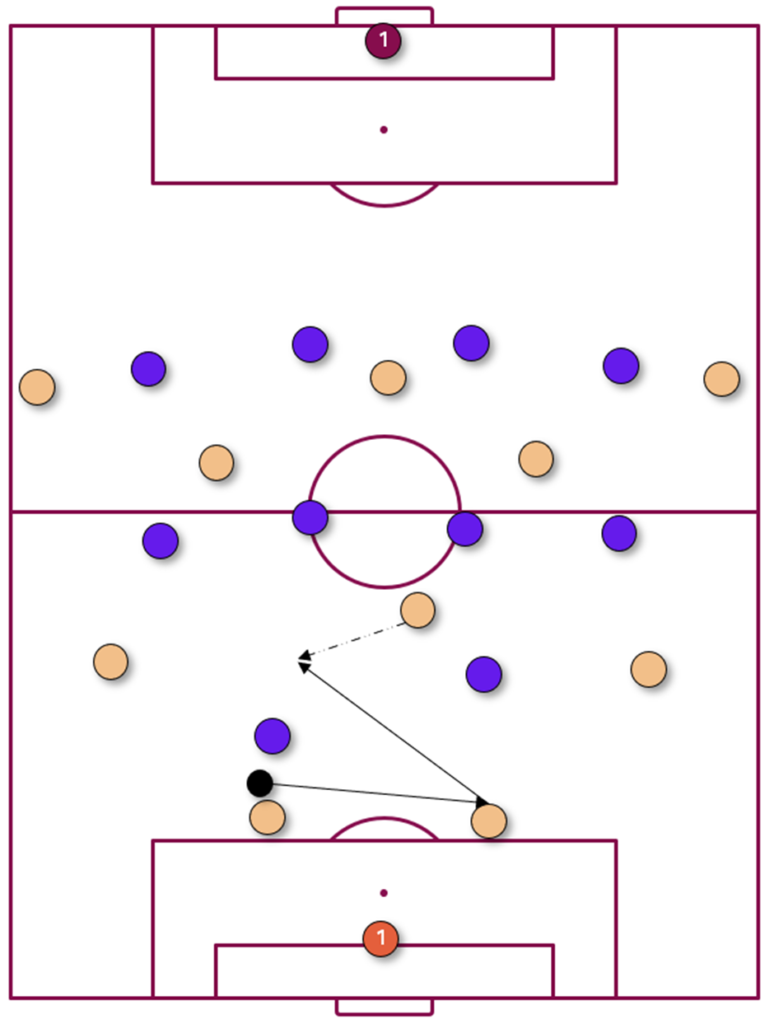
Conversely, players positioned behind the 2nd and 3rd line of pressure (midfield line), barring the diagonal positions, ought to engage in play with their backs turned to the opposing goal. Moreover, they should possess the skill to execute one-touch back passes and apply the Third Man concept. Typically, the expanse separating the midfield and defensive lines is significantly narrower compared to the distance between the attacking and midfield lines.
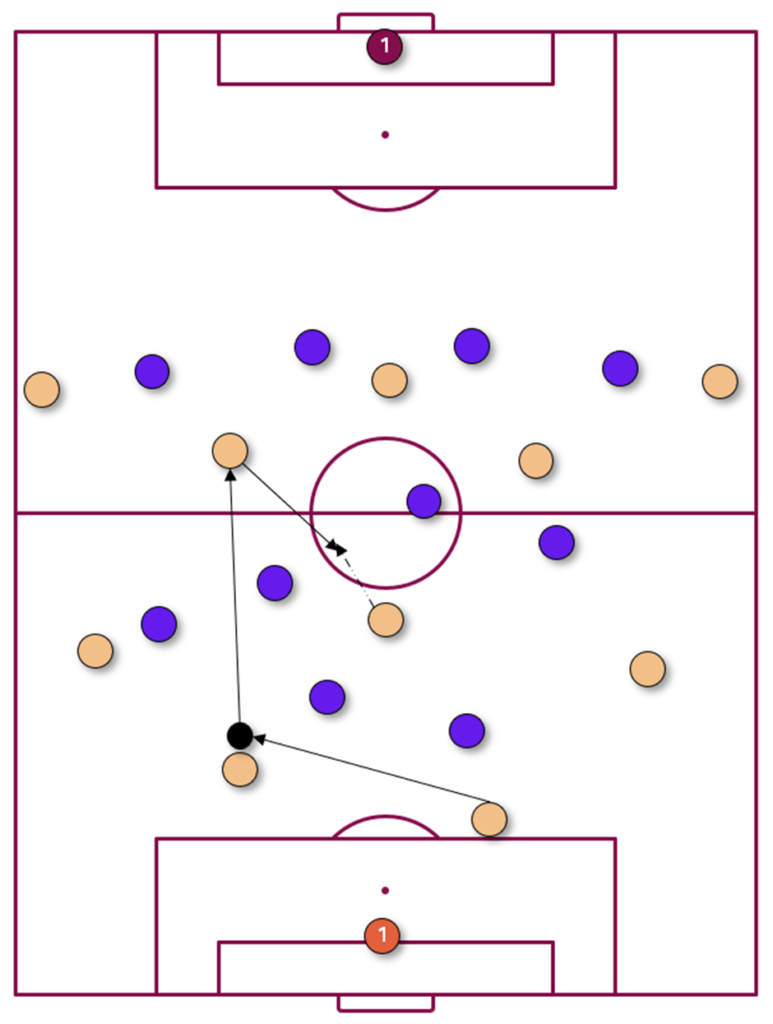
The Cornerstones of the Strategy
Midfielders, especially those who excel at playing between the lines, are the cornerstones of this strategy. They not only link the defense and attack but also provide stability and creativity. Their capacity to read the game, understand the ebb and flow of a match, and adapt to various situations is unparalleled.
These players possess an ability to find pockets of space and exploit them, creating imbalances in the opponent’s formation. Their positioning is crucial for dragging defenders out of position and creating opportunities for their teammates.
Coaching and Drills to Train “Playing between the lines”
Training drills play a pivotal role in molding players into experts of moving between the lines. Coaches emerge as the masterminds behind a team’s strategic planning and tactical implementation. Their proficiency in instilling the principles of interplay and movement within the lines stands as the differentiating factor between triumph and mediocrity on the football pitch.
Coaches develop drills and training sessions, tailored to elevate a player’s comprehension of the details of playing between the lines. These exercises aim to refine not only individual prowess but also the collective synergy of the team.
- Positional Game 4 v 4 + 4 neutrals

Description: A positional Game 4 v 4 + 4 neutrals. In each box, there is a relationship 2 v 2 + 2 neutrals. A teammate from the opposite box can drop inside the red middle zone acting as a player between the lines. Start the drill by not allowing the defenders to follow the dropback and defend inside the zone.
Attackers from the opposite box can alternate the movement of dropping inside the zone representing a real situation of two attacking midfielders dropping back to receive.
Progressions: Allow one defender to follow the attacker inside the zone. By adding small goals to each end zone it can be transformed into a small sided game.
- Rondo 6 v 3 + 1 neutrals

Description: A rondo with 6 v 3 + 1 neutral. The players in possession aim to complete 20 passes to keep the defenders inside the box. Every time a pass is done to the neutral player inside the red box and successfully gets the ball out to another teammate, it counts for +10 passes. This will “force” the attackers to look for the inside pass and the neutral inside to constantly change their position to provide support.
The defenders can move free anywhere inside the yellow and red box.
Progressions: Allow one defender to follow the attacker inside the zone.
Famous Players Known for Playing Between the Lines
Throughout football history, a number of exceptional players have demonstrated their extraordinary ability to play between the lines.
These players have imprinted an enduring legacy in football, captivating enthusiasts globally with their creative ability and tactical awareness. Let us delve deeper into the profiles of these venerable figures.
- Lionel Messi
Lionel Messi, often mentioned in the same sentence as Maradona, has taken the art of playing between the lines to extraordinary heights. With a low center of gravity and an unparalleled dribbling ability, Messi has consistently threaded his way through packed defenses to score goals and create opportunities for his teammates. His vision and passing prowess have elevated the playmaking aspect of play between the lines, making him one of the greatest footballers of all time.
- Kevin De Bruyne
In modern football, Kevin De Bruyne is firmly considered one of the best midfielders of his era. Functioning as a midfield dynamo for Manchester City, De Bruyne possesses precision in his passes with a formidable shot, allowing him the capability to break opposition defenses from more profound positions. His skill in discovering pockets of space and executing decisive passes stands as a pivotal determinant in Manchester City’s recent years of preeminence. The versatility and adaptability exhibited by De Bruyne have rendered him an indispensable component in Pep Guardiola’s strategic apparatus.
- Andres Iniesta
Andres Iniesta, a central midfielder during Barcelona’s tiki-taka era, stood forth as yet another maestro who exemplified the finesse of performing within the confines of strategic positioning. His adeptness in retaining possession and fabricating intricate passing triangulations proved pivotal to Barcelona’s triumphs. Iniesta’s transcendent mastery over the ball, coupled with his innate comprehension of positional dynamics, rendered him an authentic virtuoso in the realm of midfield prowess.
- Joshua Kimmich
Joshua Kimmich, the versatile player for Bayern Munich and the German national team, epitomizes the contemporary midfielder who excels in the nuanced spaces of the pitch. Kimmich’s adeptness in seamlessly transitioning between defensive and midfield responsibilities, coupled with his precision in passing and exceptional vision, empowers him to craft opportunities and orchestrate the game from deeper positions. His impact on Bayern’s football supremacy and Germany’s national team triumphs underscores his finesse in navigating the intricate spaces within the game.
- Bruno Fernandes
Bruno Fernandes has been a pivotal figure for Manchester United for the last few years. His ability to move between the lines has breathed new life into Manchester United’s offensive tactics. This strategic positioning between the lines has allowed him to be involved in the majority of goal scoring opportunities of Manchester United and the national Team of Portugal.
Challenges and Risks
While play between the lines can be highly effective, it comes with challenges and risks that both players and teams must navigate.
- Possession Turnovers and Counterattacks: One of the primary risks associated with playing between the lines is the possibility of possession turnovers in these high-pressure areas. When an attacking player loses the ball between the lines, it leaves the team vulnerable to swift counterattacks by the opposing side. The transition from offense to defense becomes a critical moment, requiring well-organized defensive strategies to prevent the opposition from exploiting the gaps left behind.
- Pressure and Tight Marking: Players who are positioned between the lines often face intense pressure from defenders who aim to disrupt their movement and passing. Tight marking and aggressive challenges can make it challenging for the attacking team to maintain control and execute their strategies effectively. Overcoming this pressure requires exceptional ball control, quick decision-making, and the ability to shield the ball from defenders.
- Offensive Overcommitment: Overcommitting to “play between the lines” and vertically can sometimes lead to an imbalanced team structure. If too many players push forward into these areas, it can leave the defense exposed to counterattacks. Striking the right balance between offensive creativity and defensive stability is crucial.
- Complex Tactical Execution: Playing between the lines involves complex tactical execution. Players must be in sync with their teammates, reading each other’s movements and intentions. This intricate coordination can be challenging to achieve, and it often requires extensive training and practice to execute these strategies effectively.
- Adaptation to Defensive Strategies: Opposing teams frequently adapt their defensive strategies to counter effective play between the lines. This can include employing double-marking on key playmakers, pressing high up the pitch, or utilizing a zonal marking system to limit the available space. Teams employing this strategy must be prepared to adapt to these defensive tactics and find alternative ways to break through.
- Physical and Mental Demands: Playing between the lines demands a high level of physical fitness and mental acuity. Players need to cover the ground quickly, make split-second decisions, and continuously read the game. The demand for spatial awareness and the ability to exploit small openings requires players to be in peak condition.
- Risk of Predictability: If a team becomes too predictable in its play between the lines, opponents can anticipate their movements and stifle their creativity. Successful teams often incorporate variation into their tactics to keep the opposition guessing.
- Development of Counter-Strategies: In the world of football, tactics are always evolving. As teams become more adept at playing between the lines, opponents work to develop counter-strategies to nullify these tactics. Teams must remain innovative and stay ahead of the curve to continue reaping the benefits of this approach.
Conclusion
In conclusion, playing between the lines in football is an art that enhances the game. It demands a deep understanding of tactics, precise execution, and exceptional skill. This approach empowers teams to break down organized defenses, creating excitement and moments of brilliance etched in football history. It’s not just for attacking; it can also be a game-changer when a team needs to regain control.
As the game evolves, mastering this strategy remains crucial for success. It’s a fundamental aspect of football, ensuring teams that can play between the lines will continue to dominate. It’s the magic that keeps the spirit of football alive and thriving for players, coaches, and fans.

